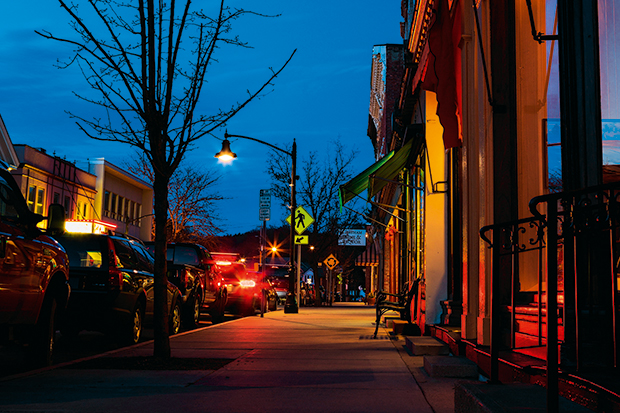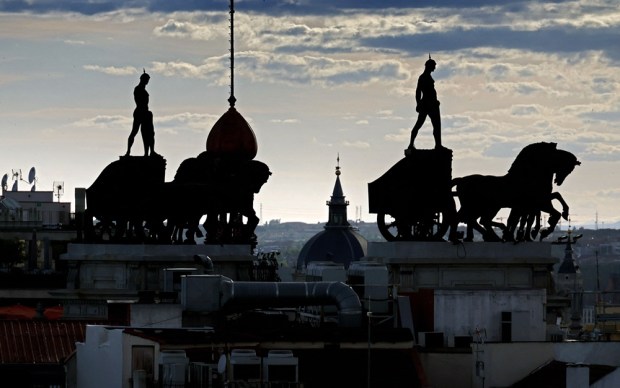Fernand Léger’s old studio now has squatters living on the doorstep. They’re an unusual sight in the new New York, especially around Bowery. These ones, at no. 222, are African and live in a huge cardboard box decorated with industrial plastic. As a pioneering modernist, Léger would have appreciated their geometry — and poverty. He’d have been less sure about the building opposite: the New Museum of Contemporary Art. It’s covered in silvery mesh, and looks like a giant speaker with a fishing boat dangling off the top. How, he might wonder, had art become so extravagant and obscure?
Poor Léger, he needn’t worry. Styles may have changed, but the world’s artists are still drifting to New York, and it’s still the capital of modern art. It’s not just about great concrete hangars stuffed with novelty and genius (The Whitney,-Guggenheim and MoMA). No other city is so brilliant, so spontaneous and so cheerfully manic. But I’ve often wondered how the artists coped with its outrageous stimuli, and what has become of their haunts. Do they still go to parties and pee in the fireplace (like Jackson Pollock did), or has the scene somehow moved on? I decided to give myself a week in NYC.
Before heading downtown, I paid a visit to the old world and dropped in on The Frick. The man who-created this urban Chatsworth (or is it a Greek temple with curtains?) was a farm boy from Pennsylvania who’d made his fortune in coal. But Henry Frick also had an eye for old masterpieces and by the time of his death in 1919 he’d acquired 3,500 works, including Titians, Tiepolos and two Vermeers. I enjoyed the thought of him sitting down to terrapins and strawberry tarts under the delicious gaze of Gainsborough’s girls. Respectability hadn’t come cheap, but then it was European. It’s odd to think that, of all the pictures on display, only one was American. How the century was about to change.
On Lexington Avenue, Georgia O’Keeffe had checked into the Marriott Eastside (then called ‘The Shelton’), as I’d do 91 years later. O’Keeffe was one of the first great artists to move to Manhattan, and she stayed in this magnificent pile of art deco for 12 years. Back in 1925 it was one of the tallest residential buildings in the world, and from her rooms on the 30th floor she turned the skyline into modern art. Much has changed, but she’d still have recognised the huge golden mailbox in the lobby and the whorl of brassy stairs. One of the doormen also remembered the old pool in the basement. That’s where Harry Houdini had done a stunt, he told me, and almost wriggled his last.
Across town, the new artists left behind a curious trail of homes. Edward Hopper lived in pink-bricked splendour at 3 Washington Square, a strangely elegant house for the cold chronicler of the lonely Midwest. As for Willem de Kooning, he’s left little trace of his pricelessness, just a succession of revolting flats along Fourth Avenue (the worst being above the dry-cleaners at number 85).
It was different for Mark Rothko. His little carriage-house at 157 East 69th looks chillingly expensive, and perhaps that’s what killed him. Un-able to cope with the fame thrust upon him, and trapped by his great ‘fields of colour’, it was here that in 1970 he took his own life.
I didn’t find all the old dives. Jasper Johns’s pad has disappeared under asphalt, and no one was quite sure where Pollock began his big, boozy life. Meanwhile, the Hotel Chelsea — once home to Claes Oldenburg and Frida Kahlo — was being slowly prised apart. Amid all the scaffolding I did find a door, but got no further than the lobby before being ordered to leave. As I was leaving, I spotted a figure hunched in a chair, who I’m sure was Sid Vicious. If he were still alive and in residence, he’d now be 59.
New York’s artists are persistent ghosts. One day, I stopped by for lunch at the Society of Illustrators (www.societyillustrators.org). Once a stylish ‘union’ for artists, it’s now open to all. A gorgeous Norman Rockwell hangs above the bar, and there are steaks and chowders on the menu and life classes every Tuesday. But it’s the artist in the attic that intrigued me — thought to be Mead-Schaeffer (1898–1980). He died here at his last exhibition, and has been rattling his pencils ever since. ‘It got so bad we had to call the exorcist,’ a former president told me.
Next I trotted round to the Art Students League. Everyone has taught here at some stage or other: Man Ray, Rothko, Pollock, O’Keeffe and Ai Weiwei. It’s always exuded an air of abstraction and chaos, and there’s still no curriculum and no degrees. They didn’t even mind me wandering around. This, I thought, is exactly how an art school should be: grimy and magnificent, a brace of nudes sprawled before an audience, and a skeleton living in the telephone kiosk.
There are still a few living abstract expressionists around, like Jim Boharry. Now 76, he dwells in an old garment factory on Great Jones Street, where we met up. I love Jim’s splashy view of life, and it was funny to find myself in this great waterfall of molten colours. But I was surprised at how small and modest it made him seem. He’d known the de Koonings and Franz Kline but they’d never dressed up, and seldom went to bars. ‘Have all that generation gone?’ I asked. ‘No,’ said Jim, ‘we still see Francesco Clemente out on his bicycle, wearing pyjamas.’
It was a few doors down, at number 57, that a new kind of artist appeared. Jean-Michel Basquiat eventually died here (of an overdose) but not before making his mark. He and Warhol were always experimenting, hitching art to music and fashion. They could often be seen in the dim red glow of the nightclub called Max’s Kansas City (213 Park Avenue South). Naturally I called by. But Max’s went bust in 1974, and the pulsing heart of my teenage years is now a Korean grocery. Back then, Debbie Harry was a waitress, and the artists would argue and fight and never pay their bills.
‘So where do they all go now?’
No one was sure.
‘The rents drove a lot of us out,’ said Alexis-Rockman, a-painter in Tribeca. Rockman, who specialises in movies (including Life of Pi) and hugely successful ecology pieces, describes a sink-or-swim world. ‘And as for the big guys, they’ve no time for bars. They’re always at dinners.’
On my last morning, I followed the big guys down to the Gramercy Park Hotel. With its rich Gothic reds, it’s a work of art in itself. But it also houses an art collection worth $50 million, including six Damien Hirsts displayed around the bar. Apart from Warhol and Basquiat, most of the artists are still alive — and very rich. Perhaps that says much for the way this city’s changed. It’s no longer grime, it seems, that makes it great.
The post New York: Dives of the artists appeared first on The Spectator.
Got something to add? Join the discussion and comment below.
Get 10 issues for just $10
Subscribe to The Spectator Australia today for the next 10 magazine issues, plus full online access, for just $10.














Comments
Don't miss out
Join the conversation with other Spectator Australia readers. Subscribe to leave a comment.
SUBSCRIBEAlready a subscriber? Log in